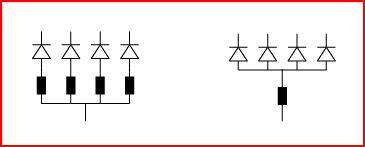Curious (for general knowledge), why this is better than a single Resistor for all LEDs?
It depends on how they are wired & controlled, but it' related to [u]Ohm's Law[/u] and [u]Kirchhoff's Laws[/u].
You may already know Ohm's Law, and it's pretty simple to understand as long as you "get" that resistance is the resistance to current flow... Higher resistance = less current (and higher voltage means more current).
But, Kirchhoff's Laws (which describe how voltages & currents divide and sum in series & parallel circuits) require a bit more study, especially if you haven't taken a basic electronics class.
Further complicating things is the fact that LEDs are non-linear... Their resistance changes (drastically) with voltage, so although Ohm's Law is true (it's a law of nature) it's difficult to apply to LEDs.
...But, without all of those "laws" you can think of the old water-flow analog* where water-flow in a pipe represents current and water pressure represents voltage. A small-skinny pipe is a high resistance and a fat pipe has less resistance.
You CAN put multiple LEDs in series with one resistor as long as you have enough voltage. If you have 3 LEDs (at about 2V each) a resistor, and 12V power supply, it works perfectly because in series the same current flows through all of the LEDs and through the resistor, and you get (about) 2V across each LED with 6V "remaining" across the resistor. But of course, you can't control them separately because the same current is flowing through all of them.
You can wire them in parallel (with one series resistor) but there a couple of issues... The current is limited by the resistor and is split between the two LED. But because of that non-linearity and manufacturing variations the current may not split evenly and one LED may be brighter than the other. You can often get-away with it, but it's "bad practice".
It is possible to control the parallel LEDs separately but since the current is controlled by the resistor, the same current flows when one LED is turned-off and all of current goes-through the other LED and it gets brighter... No good!
* A couple of things about the water analogy - If you cut a water pipe you get zero-resistance and water flow-out everywhere. If you cut a wire you get infinite resistance and no current flows. And with water, nothing bad happens when there is no resistance (except maybe a flood  ) but with electronics, zero-resistance is a "short circuit", too much current flows and stuff burns-up (or a circuit breaker blows, etc.).
) but with electronics, zero-resistance is a "short circuit", too much current flows and stuff burns-up (or a circuit breaker blows, etc.).
![]()
